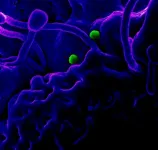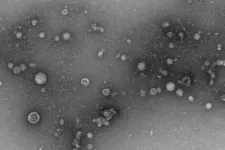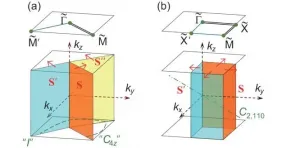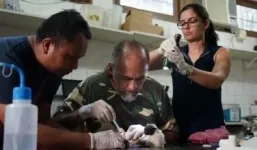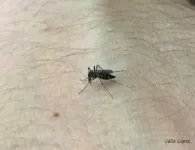Give the heart a ketone? It may be beneficial
Review finds emerging evidence ketone therapy holds potential for cardiovascular intervention
2021-02-23
(Press-News.org) There is growing evidence that ketone bodies may be beneficial to heart disease patients regardless of the method of delivery used to increase ketone delivery to the heart. A Journal of the American College of Cardiology review paper examines emerging evidence regarding ketone bodies' effects on the heart and the potential for ketone therapy as a cardiovascular intervention in heart disease patients.
In recent years ketone bodies entered the popular lexicon through the "keto diet," which consists of a very low carbohydrate and high fat diet that endeavors to force the body into ketosis. This is a metabolic state with increased ketone bodies circulating in the body as a result of less glucose, or sugar, being in the bloodstream to provide fuel, causing the body to shift to metabolize fat as energy. Recent research has shown that a keto diet may contribute to increased risk for heart disease if the foods consumed do not include heart healthy fats.
The review discusses the therapeutic advantages of increasing circulating ketone levels through multiple mechanisms, including the keto diet. The researchers discuss both the potential merits and concerns related to the keto diet in relation to each mechanism for increasing ketone levels in the body, providing novel therapeutic avenues to increase ketosis without the concerning impacts of the keto diet.
"We found that data from experimental and human studies suggest ketone bodies exert protective effects on patients with heart disease. As heart disease remains the leading killer worldwide, determining new ways to offer cardiac protection is vital to this patient population," said B. Daan Westenbrink, MD, PhD, a cardiologist and translational scientist at University Medical Center Groningen in the Netherlands and senior author on the paper. "While the keto diet has become increasingly popular, there are concerns about untoward effects on the heart. However, administration of ketones may be an alternative to a keto diet as a means of elevating ketone bodies for their protective effects."
Ketone bodies are produced by the liver, particularly in response to prolonged fasting, insulin deprivation and extreme exercise. Ketones provide additional energy to multiple organs, and under extreme conditions ketone bodies may account for approximately 5-20% of total energy expenditure by the body.
Under normal conditions, a healthy heart consumes little glucose as an energy source. However, in the early stages of structural heart disease there is a switch from fatty acids to glucose utilization. This metabolic reprogramming leads to heart muscle energy starvation, contributing to the development of heart failure. According to the researchers, a failing heart seems to reprogram its metabolism to increased reliance on ketone bodies as a fuel source.
According to the researchers, ketones may also have positive effects on common cardiovascular risk factors, including blood pressure, body weight, blood glucose or blood sugar, and cholesterol, though research is ongoing. Research has also shown ketone bodies may provide additional cardiovascular benefits impacting endothelial function, inflammation, cardiac remodeling and mitochondrial function.
These benefits could be achieved through the keto diet, but long term compliance to the diet is low, often due to gastrointestinal distress. There are alternatives to the keto diet or ingesting ketone precursors to achieve ketosis, which include ingesting ketone salts or ketone esters.
"With numerous pathways to achieve ketosis, ketone bodies have potential clinical implications that require further study," Westenbrink said. "Further exploration of therapeutic approaches to harness the beneficial effects of ketosis are necessary. I believe in the coming years we will have a much better grasp on whether ketone bodies can be optimized and used in the treatment and prevention of heart disease."
INFORMATION:
The American College of Cardiology envisions a world where innovation and knowledge optimize cardiovascular care and outcomes. As the professional home for the entire cardiovascular care team, the mission of the College and its 54,000 members is to transform cardiovascular care and to improve heart health. The ACC bestows credentials upon cardiovascular professionals who meet stringent qualifications and leads in the formation of health policy, standards and guidelines. The College also provides professional medical education, disseminates cardiovascular research through its world-renowned JACC Journals, operates national registries to measure and improve care, and offers cardiovascular accreditation to hospitals and institutions. For more, visit acc.org.
The Journal of the American College of Cardiology ranks among the top cardiovascular journals in the world for its scientific impact. JACC is the flagship for a family of journals--JACC: Cardiovascular Interventions, JACC: Cardiovascular Imaging, JACC: Heart Failure, JACC: Clinical Electrophysiology, JACC: Basic to Translational Science, JACC: Case Reports, JACC: CardioOncology and JACC: Asia--that prides themselves in publishing the top peer-reviewed research on all aspects of cardiovascular disease. Learn more at JACC.org.
ELSE PRESS RELEASES FROM THIS DATE:
2021-02-23
WHAT:
A randomized, placebo-controlled Phase 1 clinical trial of two monoclonal antibodies (mAbs) directed against the coronavirus that causes Middle East respiratory syndrome (MERS) found that they were well tolerated and generally safe when administered simultaneously to healthy adults. The experimental mAbs, REGN3048 and REGN3051, target the MERS coronavirus (MERS CoV) spike protein used by the virus to attach to and infect target cells. The mAbs were discovered and developed by scientists at the biopharmaceutical company Regeneron, located in Tarrytown, New York. The trial was sponsored by the National Institute of Allergy and Infectious Diseases (NIAID), part of the National Institutes of Health.
The trial was the first to test the experimental antibodies
Hyperlink Code ...
2021-02-23
Inflammatory lung diseases such as asthma, COPD and, most recently, COVID-19, have proven difficult to treat. Current therapies reduce symptoms and do little to stop such diseases from continuing to damage the lungs. Much research into treating chronic inflammatory diseases has focused on blocking chemicals called cytokines, which trigger cascades of molecular events that fuel damaging inflammation.
Now, scientists at Washington University School of Medicine in St. Louis have found that such cytokines can drive inflammation in more ways than previously understood, perhaps revealing new routes ...
2021-02-23
Using the symmetries of the systems, people can define various topological invariants to describe different topological states. The topological materials can be accurately discovered by calculating the topological invariants. Recently, researchers found that irreducible representations and compatibility relationships can be used to determine whether a material is topological nontrivial/trivial insulator (satisfying the compatibility relations) or topological semimetal (violating the compatibility relations), which leads to a large number of topological materials predicted by theoretical calculations. However, Weyl semimetals go beyond this paradigm because the existence of Weyl fermions does not need any symmetry protections (except for lattice translation symmetries). At present, ...
2021-02-23
Urban areas are on the rise and changing rapidly in form and function, with spillover effects on virtually all areas of the Earth. The UN estimates that by 2050, 68% of the world's population will reside in urban areas. In the inaugural issue of npj Urban Sustainability, a new Nature Partner Journal out today, a team of leading urban ecologists outlines a practical checklist to guide interventions, strategies, and research that better position urban systems to meet urgent sustainability goals.
Co-author Steward Pickett of Cary Institute of Ecosystem Studies explains, "Urban areas shape demographics, ...
2021-02-23
By Maria Fernanda Ziegler | Agência FAPESP – Yellow fever was the first human disease to have a licensed vaccine and has long been considered important to an understanding of how epidemics happen and should be combated. It was introduced to the Americas in the seventeenth century, and high death rates have resulted from successive outbreaks since then. Epidemics of yellow fever were associated with the slave trade, the US gold rush and settlement of the Old West, the Haitian Revolution, and construction of the Panama Canal, to cite only a few examples.
Centuries after the disease was first reported in the Americas, an international team of researchers will embark on a groundbreaking study to develop ...
2021-02-23
What should researchers do if they encounter a study participant who reports suicidal thoughts?
UIC College of Nursing associate professor Susan Dunn explores this question as lead author of "Suicide Risk Management Protocol for a Randomized Controlled Trial of Cardiac Patients Reporting Hopelessness," a paper published in the January/February edition of Nursing Research.
Suicide is ranked as the 10th leading cause of death for all ages in the U.S. and can be identified through clinical research, according to the paper.
Although suicide screening tools are widely available for patients in emergency, hospital and primary care settings and ...
2021-02-23
The environmental impacts of removing dingoes from the landscape are visible from space, a new UNSW Sydney study shows.
The study, recently published in Landscape Ecology, pairs 32 years' worth of satellite imagery with site-based field research on both sides of the Dingo Fence in the Strzelecki Desert.
The researchers found that vegetation inside the fence - that is, areas without dingoes - had poorer long-term growth than vegetation in areas with dingoes.
"Dingoes indirectly affect vegetation by controlling numbers of kangaroos and small mammals," says Professor Mike Letnic, senior author of the study and researcher at UNSW's Centre ...
2021-02-23
Since astronomers captured the bright explosion of a star on February 24, 1987, researchers have been searching for the squashed stellar core that should have been left behind. A group of astronomers using data from NASA space missions and ground-based telescopes may have finally found it.
As the first supernova visible with the naked eye in about 400 years, Supernova 1987A (or SN 1987A for short) sparked great excitement among scientists and soon became one of the most studied objects in the sky. The supernova is located in the Large Magellanic Cloud, a small companion galaxy to our own Milky Way, only about 170,000 light-years from Earth.
While astronomers watched debris ...
2021-02-23
Unlike the Higgs boson, discovered at CERN's Large Hadron Collider in 2012 after a 40-year quest, the new particle proposed by these researchers is so heavy that it could not be produced directly even in this collider
The University of Granada is among the participants in this major scientific advancement in Theoretical Physics, which could help unravel the mysteries of dark matter
Scientists from the University of Granada (UGR) and the Johannes Gutenberg University Mainz (Germany) have recently published a study in which they endeavour to extend the Standard Model of particle physics (the equivalent of 'the periodic table' for particle physics) and answer some of the questions that this model is unable to answer. Such puzzles include: What ...
2021-02-23
This study, published recently in the international journal Insects, was conducted by researchers from the University of Granada, the Doñana Biological Station, and the Biomedical Research Networking Centre for Epidemiology and Public Health (CIBERESP)
Researchers from the University of Granada (UGR), the Doñana Biological Station (EBD-CSIC), and the Biomedical Research Networking Centre for Epidemiology and Public Health (CIBERESP) have carried out the most comprehensive study to date of the eating patterns of the tiger mosquito (Aedes albopictus) and other invasive species of the same genus in Europe. The results of the study were recently published in the international journal Insects.
This research, which reviews ...
LAST 30 PRESS RELEASES:
[Press-News.org] Give the heart a ketone? It may be beneficial
Review finds emerging evidence ketone therapy holds potential for cardiovascular intervention
